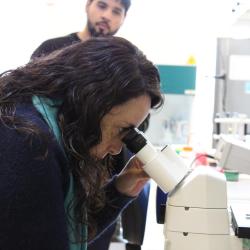
Dr. Cristian Vilos leads the research group oriented to the development of Nanobiomedicine. This research line has extensive experience in the use of polymeric nanoparticles with biodegradable and biocompatible properties as drug delivery systems and is focused on the preclinical development of numerous nanotherapeutic platforms as drug delivery systems for various diseases or pathophysiological conditions including chronic pain, endometrial, prostate and colorectal cancer, as well as muscular dystrophies.
All of the above,together with the study of the interactions of nanomaterials with biological systems (nano-bio), the self-assembly of nanostructures and the fundamental mechanisms involved in biological response and nanotoxicology, represent the main areas of interest of the researchers of Cedenna's Nanobiomedicine group.
Technology transfer is also a fundamental key to the challenges of the Nanobiomedicine group. In this context, technologies associated with the sustained release of antibiotics for the animal production industry and the management of chronic pain in humans have been patented as a product of the work of this group.
Chronic Pain: Chronic pain affects society as a whole and occurs due to a lesion in the somatosensory nervous system or as a consequence of the physiopathological development of a chronic disease such as cancer, arthritis, diabetes or fibromyalgia.
Dr. Luis Constantil focuses his research on understanding the neurophysiology of pain and developing new therapeutic strategies based on drug-loaded nanoparticles for the relief of chronic pain.
In this context, the inhibition of glial cells by pentoxifylline-loaded nanoparticles, the inhibition of pannexin channels by carbenoxolone, probenecid or 10panx administered in polymeric nanoparticles, or the use of drug delivery systems with ketamine to perform NMDA channel inhibition, are some of the strategies developed for the management of chronic pain.
Also, Prof. Constandil, in collaboration with Monash University, has worked on pH-sensitive nanoparticles capable of blocking theintracellular NK1 receptor with the neurokinin receptor antagonist (aprepitant), achieving publication in the prestigious journal Nature Biotechnology. Dr. Constandil is also currently working on other initiatives, such as increasing the intestinal absorption of N-acetyl-cysteine, a molecule beneficial to our body for its exceptional antioxidant power, through its encapsulation in PLGA nanoparticles coated with poloxamer 188; and development of high-strength PLA polymer films with lignin nanoparticles to improve the fixation of natural pesticides such as cinnamaldehyde.
Endometrial and prostate cancer: In the present day of oncology we face tremendous challenges oriented towards the search for early detection tools, the development of new, more effective and less toxic molecules to combat cancer and the creation of drug delivery systems to reduce the adverse effects of clinically used chemotherapeutic agents.
Dr. Orihuela's research focuses on the development of new PEG-functionalized TiO2 and MgO2 nanocomposites loaded with the promising antitumor agent 2-methoxyestradiol. For this research, in vitro models such as human prostate and endometrial cancer cell lines are used.
In addition, Dr. Orihuela collaborates with Dr. Patricio Vargas and Dr. Juliano Denardin to analyze the physicochemical aspects of these nanosystems. Another current line of research is a collaborative project with the company Biofresco Ltda, related to the loading of MgO2-PEG nanoparticles with maqui and celery plant extracts for the treatment of endometrial cancer and leiomyomas.
Colorectal cancer: Colorectal cancer has a high prevalence worldwide and despite remarkable advances in its treatment, a significant morbidity and mortality rate is still observed. Tumor cells have evolved different strategies to escape the induction of cell death by chemotherapy. Consequently, therapies that aim to interfere with signal transduction pathways using a single drug may be insufficient to achieve tumor recession. Therefore, the application of combination chemotherapy through the synergistic effect of two agents targeting different cellular pathways (genes or cell cycle checkpoints in the cancer process) could increase the chances of eliminating cancer. Modern medicine has high hopes for the use of nanotechnology in its battle against cancer.
In fact, the use of nanoparticles as drug carriers may solve, in part, the colossal problem related to the high toxicity of chemotherapeutic agents.
Some notable improvements in oncology applications include theenhancement of desirable pharmacological properties of drugs (e.g.,circulating half-life, tumor accumulation, stability, solubility, etc.), reduction of dose-limiting side effects of cytotoxic drugs, and co-delivery of multiple drugs to enhance therapeutic efficacy.
In this context, the research of Dr. Cristian Vilos focuses on the study of lipid-polymer nanoparticles loaded with combined therapeutic agents based on clinically approved cytotoxic agents (5-fluorouracil, irinotecan and oxaliplatin) and inhibitors of mitogen-activated protein kinase (MAPK) and mammalian target of rapamycin (mTOR), among others that regulate critical pathways involved in colorectal cancer proliferation, metastasis and resistance.
Dr. Vilos also focuses on the development of advanced nanotherapies for the intracellular delivery of macromolecules, improvements in the delivery of poorly soluble drugs, co-delivery of therapeutic agents and the advancement of therapies based on targeted delivery of drugs to particular cells or tissues (Targeted Delivery). The fundamentals of his research involve various fields of "drug development", which also incorporate advanced materials and the use of copolymers,
stimuli-responsive biopolymers and biodegradable & biocompatible biopolymers for use in nanopharmacology.
Muscular Dystrophies: Muscular pathologies are a broad spectrum of diseases with metabolic and genetic causes. Characteristics of these pathologies include skeletal muscle weakness, wear and tear, atrophy, and cycles of degeneration and regeneration.
Although numerous strategies based on pharmacological agents, genetherapy and cellular therapeutics are being developed to treat orameliorate muscle pathologies, the application of nanotechnology fosters promising opportunities. The renin-angiotensin system (RAS) is the central regulator of blood pressure and fluid balance in the body, and was recently found to be activated in several types of muscle dysfunction.
Group leader: Cristian Vilos







